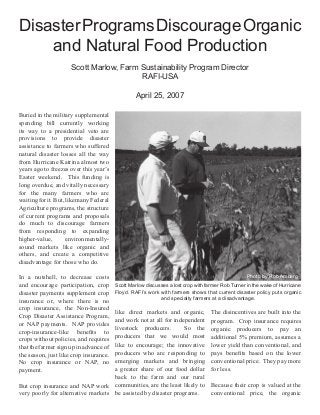
Disaster Programs Discourage Organic and Natural Food Production
- 1. Buried in the military supplemental spending bill currently working its way to a presidential veto are provisions to provide disaster assistance to farmers who suffered natural disaster losses all the way from Hurricane Katrina almost two years ago to freezes over this year’s Easter weekend. This funding is long overdue, and vitally necessary for the many farmers who are waitingforit. But,likemanyFederal Agriculture programs, the structure of current programs and proposals do much to discourage farmers from responding to expanding higher-value, environmentally- sound markets like organic and others, and create a competitive disadvantage for those who do. In a nutshell, to decrease costs and encourage participation, crop disaster payments supplement crop insurance or, where there is no crop insurance, the Non-Insured Crop Disaster Assistance Program, or NAP payments. NAP provides crop-insurance-like benefits to crops without policies, and requires that the farmer sign up in advance of the season, just like crop insurance. No crop insurance or NAP, no payment. But crop insurance and NAP work very poorly for alternative markets like direct markets and organic, and work not at all for independent livestock producers. So the producers that we would most like to encourage; the innovative producers who are responding to emerging markets and bringing a greater share of our food dollar back to the farm and our rural communities, are the least likely to be assisted by disaster programs. The disincentives are built into the program. Crop insurance requires organic producers to pay an additional 5% premium, assumes a lower yield than conventional, and pays benefits based on the lower conventional price. They pay more for less. Because their crop is valued at the conventional price, the organic DisasterProgramsDiscourageOrganic and Natural Food Production Scott Marlow, Farm Sustainability Program Director RAFI-USA April 25, 2007 Scott Marlow discusses a lost crop with farmer Rob Turner in the wake of Hurricane Floyd. RAFI’s work with farmers shows that current disaster policy puts organic and specialty farmers at a disadvantage. Photo by Rob Amberg
- 2. producer has a smaller percentage of his return covered by more expensivepolicies. Becauseorganic producers get lower crop insurance benefits for higher premiums, they are less likely to participate in the program. Because they do not participate in the program, even though it is the correct financial decision, they are then excluded from crop loss payments. While the disadvantages are obvious for organic production, they are even more extreme for more recently emerging markets like grass-fed beef, pastured pork or poultry, and vegetables marketed directly to restaurants or at farmers markets. The effects do not end with disaster programs. When innovative farmers go in to see their banker to get operating loans, they are at a financial disadvantage. Operating loans use the crop as collateral. Generallytheworthofthatcollateral is based on assured income, which is determined by, you guessed it, crop insurance. Bankers seldom value specialty crops at their full value without some assurance because, as one banker told RAFI, “Just because you can get that price for it doesn’t mean I can get that price for it if you go belly up.” The lack of effective crop insurance doesn’t just hurt in the event of a disaster, it hurts every time they go to the bank. Which brings us to the most common disaster assistance program; the emergency loan program. Emergency loans are available from local Farm Services Agency offices whenever a disaster is declared. They provide low- interest loans, usually around 3 ¾% for the amount of the documented losses. But the farmer still has to be eligible for the loan, and must show repayment ability. That budget is once again determined by the valuation of the crop, and the availability of crop insurance, and once again the innovative farmer is at a disadvantage. In recent years a whole series of federal and state programs have aimed at encouraging farmers to follow emerging markets and carry the value of their crops further into the marketplace. But at the same time, our agricultural financial infrastructure, determined by federal policy, makes it almost impossible to survive if they do. The bridge to the future becomes a cliff. It is about time that our federal programs reward those innovative farmers who follow emerging markets and provide fresh food directly to our communities. In the long term, we must develop crop insurance that provides effective risk management for innovative crops and markets. Programs like the Adjusted Gross Revenue crop insurance program show some promise, but extremely slow rates of adoption show that they are not yet effective. Beyond these pilots, according to USDA officials, we are looking at 10 to 15 years for the development of new programs. In the mean time, which means in this disaster supplemental and in this farm bill, we must shift the terms of crop insurance and disaster programs to recognize higher value markets when the farmer can document a price history, eliminate the increased premium for organic, develop price and yield histories for alternative markets and address the needs of our growing community of farmers providing fresh foods directly to consumers. We have all said that this is the transition that we want to see. We now have to make it possible for farmers to make it. RAFI is a nonprofit organization that works for community, equity, and diversity in agriculture. For more information on RAFI or our work on disaster programs, visit our Web site, www.rafiusa.org.
